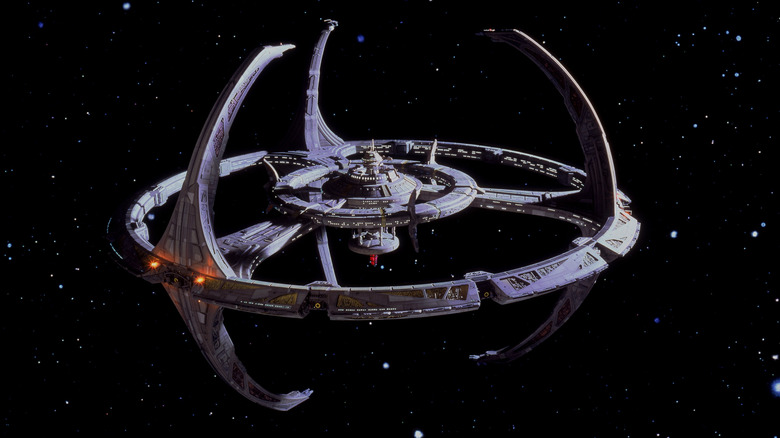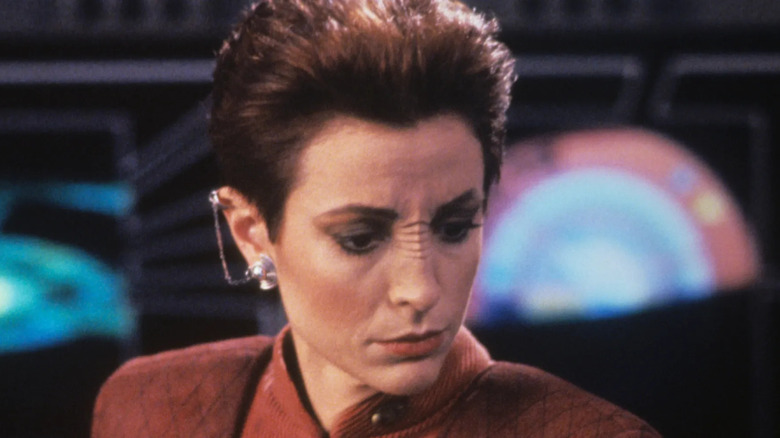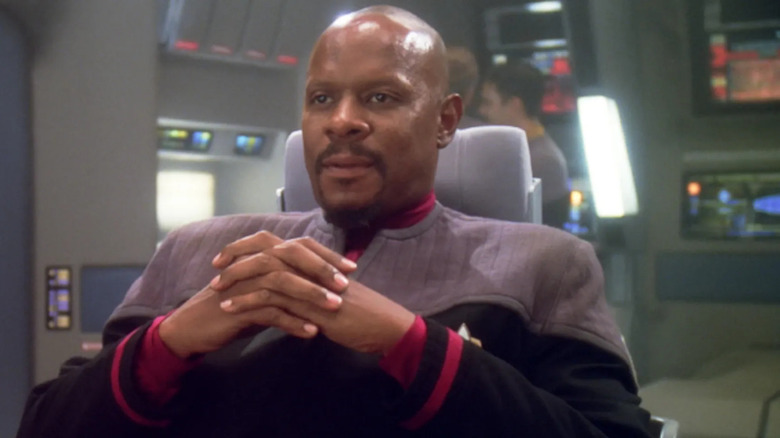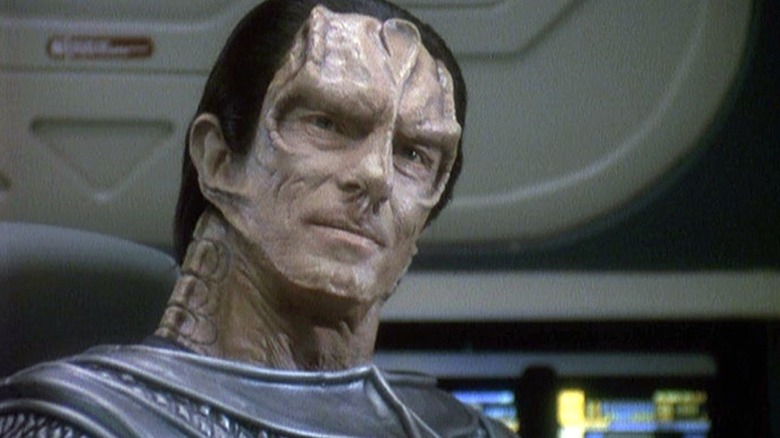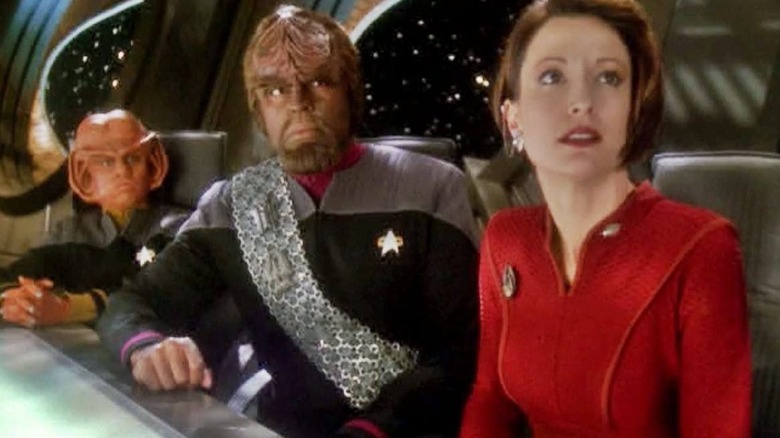Star Trek: Deep Space Nine's Setting Enhanced The Show's Drama – And Changed What The Franchise Was All About
"Star Trek: Deep Space Nine" — which celebrated its 30th anniversary on January 3 — has come to be one of the more celebrated of the "Star Trek" series. During the show's run, it was never as well-received or as popular as "Star Trek: The Next Generation," which overlapped with DS9 during its sixth and seventh seasons. This author is old enough to recall the scuttlebutt at Trek conventions, and finding that many fans objected to the show's darker tone, as well as its setting. Deep Space Nine was a space station, leading many to point out that the word "Trek" in the title was instantly inappropriate. The station had a few small, long-range shuttlecrafts called runabouts, but none of the show's stories were about exploring the galaxy or missions of discovery. Indeed, "Deep Space Nine" was about conflict, war, religion, economics, and all the other themes that Trek traditionally eschewed.
The three previous "Star Trek" shows were overseen by the franchise's original creator, Gene Roddenberry, and he — perhaps infamously — dictated a rule to his writers that interpersonal conflict among a starship crew was not permitted. In the future, Roddenberry felt, human beings would be able to more efficiently and happily work as a team, and dictated that all threats and conflicts had to come from without. "Deep Space Nine" was the first show to be made without Roddenberry's input — he passed away in 1991 — and the new show's creators, Rick Berman and Michael Piller, seemingly gave themselves free rein to play with the types of conflicts Roddenberry disliked.
Boldly staying where no one has stayed before
For many, this deliberate departure from traditional star trekking was the show's greatest strength, and the show's fans feel that DS9's ability to delve into dark territory only made it richer and more complex.
The premise of the show was unusually intense for "Star Trek." The distant planet of Bajor had, for several decades, been occupied by the murderous, Nazi-like Cardassians. The Bajorans, thanks to their resistance efforts, had finally liberated themselves, but their planet's government was in shambles. In order to oversee Bajor's reconstruction, a nearby Cardassian space station was handed over the Federation, and was staffed by multiple Starfleet officers. Commander Sisko (Avery Brooks) had to ensure the station's repair — the Cardassians destroyed a lot of it on the way out — and work with the Bajoran Major Kira (Nana Visitor) to keep her planet from collapsing into anarchy.
Bajor was on the precipice of becoming a corrupt theocracy in its post-war years, but was held in check by the fact that Sisko had discovered a stable wormhole near Bajor that many of the locals considered to be a Celestial Temple where their deities, The Prophets, lived. Indeed, non-corporeal aliens lived the wormhole, and Sisko's contact with them made him the Bajoran Emissary, a holy figure indeed.
Unlike previous Trek shows, though, "Deep Space Nine" was about longterm plans. Sisko, Kira, and the rest of the enormous cast weren't on a short, simple mission of one-time diplomacy. They wouldn't be able to clock out for the day after having, say, delivered relief aid. Saving Bajor was a mission that would take many, many years. And there were no ships to sail away in.
Indeed, the stationary nature of the series altered Trek's very ethic.
Sailing off without following up
Many Trekkies have acknowledged that both the original "Star Trek" and "Star Trek: The Next Generation" often had episodic endings that were a mite too tidy. Kirk (William Shatner) or Picard (Patrick Stewart) would recklessly solve a problem and then merrily sail off into the stars, rarely going back to check in. No further mention would be made in future episodes either. It woulsn't be many years later, until the making of "Star Trek II: The Wrath of Khan," that the consequences of Kirk's actions would come back to haunt him. In the episode "Space Seed" (Februrary 16, 1967) the genetically enhanced soldier Khan (Ricardo Montalbán) was left on an uninhabited planet with his retinue in order to build a society from scratch. 15 years later, audiences finally learned that things didn't do so well for Khan, as a natural disaster reduced the planet to a desert.
Where was Kirk? Gallivanting about the galaxy, not thinking about it.
Similarly, the animated series "Star Trek: Lower Decks" finally, after 20 years, began relitigating some of Captain Picard's more careless abandon. What happened, for instance, after the events of the episode "Symbiosis" (April 18, 1988)? A whole world had been forced to become addicted to drugs, held in a cycle of addiction by their neighboring world for many decades. The Enterprise discovered the addiction scheme, and took actions to assure the cycle would break. Then they sailed away, not bothering to aid the addicts in their recovery. A 2022 episode of "Lower Decks," "Trusted Sources," pointed out that the addicts went through a very dark time for many, many years.
Where was Picard? Gallivanting about the galaxy, not thinking about it.
Anti-gallivanting
"Deep Space Nine" was, then, the anti-gallivanting show. Sisko, because of the nature of his mission — and because of the show's very premise — couldn't gallivant through the galaxy when he seemingly solved a problem, even in the short term. Sisko didn't have the luxury of leaving his problems behind. He needed to stay, develop long-term relationships with some pretty monstrous people, and, most significantly, live with the consequences of his actions. There were no short-term solutions in "Deep Space Nine," because the same players would still be living nearby when Sisko and Kira were done.
However, "Deep Space Nine" was not a show about slow and careful Starfleet diplomacy because most of its characters — in a novel twist — weren't members of the Federation. It was set in a heterogenous world, where alien species still practiced capitalism, still worshiped openly, still employed violent tactics and displayed military dominance. This was not the antiseptic world of Starfleet where everyone gets along. This was a world that required more than what mere, soft-spoken diplomacy could provide. As such, "Deep Space Nine" would eventually devolve back into war with "Axis" and "Allies" fighting over who controls the seat of power in the whole galaxy.
Sisko occasionally had to take some pretty serious steps during wartime, often ordering people to their deaths. People got hurt on DS9, and there would be no distance to cure them. They had to return home, to a turbulent home on a bustling space station, perhaps still under attack, and heal there.
War trauma
Case in point, the Ferengi Nog (Aron Eisenberg) was a mere teenager, maybe 13, at the outset of the show. No Ferengi had ever entered Starfleet before, but Nog, inspired by the humans he recently met, decided to apply, eventually graduating as an officer. Nog would seem to, at this point in his arc, represent Trek's ethos of acceptance and multiculturalism. Nog, however, is almost immediately consigned to the war effort, and has to take up weapons. He eventually loses a foot in battle. In the future, new feet can be regrown without too much medical issue, but the wound left Nog traumatized. In the episode "It's Only a Paper Moon" (December 28, 1998), Nog moves into a holosuite and lives in a fantasy version of 1960s Las Vegas as a means to escape the raging war outside.
Nog's graduation from ne'er-do-well youth to noble officer was marked by violence. And the show's structure didn't allow for Nog to simply "get back to work." In the Trek shows that are constantly on the move, their trekking becomes symbolic. Trekking denotes exploration, and even — if we're to be frank about Trek's frequent colonialist leanings — fulfilling some sort of sci-fi Manifest Destiny. In being on the frontier, in being constantly on the move, Trek seems to argue, one is in a constant state of renewal. Every new contact is a new beginning. In this world, no one is permitted a second act.
In staying put, DS9 is forced to work through its trauma directly. The symbol of constant renewal is gone, and what remains is an emotional, political, economic, and religious miasma that requires time, deep thought, and difficult solution. DS9 in that regard, is mature, willing to feel the pain and take steps to slowly heal.
